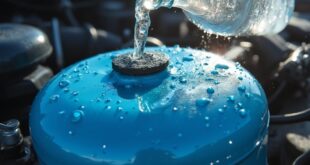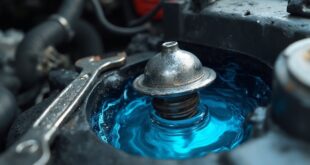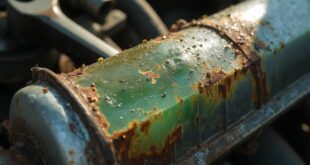If you're facing a coolant leak, look for these common culprits: a leaking radiator hose, loose clamps, a faulty water pump, a leaking thermostat housing, a bad heater core, or a blown head gasket. Each issue can escalate quickly, causing serious engine damage. Fixing them may involve tightening, replacing parts, or more extensive repairs, with costs varying widely. Don't ignore these signs; there's more to uncover about preventing and addressing these problems efficiently.
Leaking Radiator Hose
When you notice a leaking radiator hose, it's crucial to address the issue promptly, as even small leaks can lead to significant problems.
Radiator hoses transport coolant, and over time, they can crack due to age and wear. Inspect your hoses regularly for signs of damage, such as bulges or tears.
If you find a leak, replacing the hose immediately can prevent overheating and engine damage.
Loose or Weak Radiator Hose Clamp
Addressing a leaking radiator hose is important, but don't overlook the role of the radiator hose clamp. A loose or weak clamp can lead to coolant leaks, causing potential engine overheating.
Regularly inspect these clamps for signs of wear or looseness. If you notice any issues, tightening or replacing the clamp can prevent further problems. It's a simple fix that can save you from costly repairs down the line.
Leaking Water Pump
A leaking water pump can quickly lead to serious cooling system issues, so it's vital to recognize the signs early.
Look out for these symptoms:
- Coolant puddles under your vehicle
- Unusual groaning or whining noises from the pump
- Frequent overheating of the engine
- Low coolant levels despite no visible leaks
If you notice any of these signs, it's important to address the issue promptly.
Ignoring it can result in costly repairs down the line.
Regular inspections and maintenance can help prevent water pump leaks and keep your engine running smoothly.
Leaking Thermostat Housing
A leaking thermostat housing can quietly disrupt your vehicle's cooling system, leading to overheating if not addressed promptly. If you notice coolant pooling under your car or your temperature gauge rising, it's time to inspect the thermostat housing.
| Symptoms | Causes | Solutions |
|---|---|---|
| Coolant puddles | Aging seals | Replace thermostat housing |
| Overheating engine | Cracked housing | Inspect and tighten bolts |
| Fluctuating temperature | Faulty thermostat | Replace the thermostat |
Addressing this issue early can save you from costly repairs and keep your engine running smoothly.
Bad Heater Core
When you notice a sweet smell in your cabin or find coolant on your floor mats, it's likely a sign of a bad heater core. This component is essential for heating your cabin but can develop pinhole leaks, causing coolant to escape.
Here are some symptoms to look out for:
- Foggy windows due to coolant vapor
- Warm air blowing from the vents when the heat is off
- A drop in coolant levels
- Overheating engine
If you suspect a bad heater core, it's vital to address it quickly to avoid further damage and costly repairs.
Blown Head Gasket
Signs of a blown head gasket can often appear after dealing with issues like a bad heater core. You might notice coolant mixing with oil or white smoke from the exhaust. Ignoring these signs can lead to severe engine damage and costly repairs.
| Symptoms | Feelings | Consequences |
|---|---|---|
| Overheating engine | Frustration | Major engine failure |
| Poor performance | Anxiety | Expensive repair bills |
| Oil contamination | Helplessness | Extended repair downtime |
| White smoke | Panic | Risk of complete breakdown |
Addressing a blown head gasket promptly is essential.
Risks of Driving With a Coolant Leak
Driving with a coolant leak isn't just risky; it can lead to severe engine damage if left unaddressed. Ignoring even a small leak can escalate quickly, resulting in costly repairs down the line.
Here are some key risks to take into account:
- Engine overheating can cause catastrophic failures.
- Hose or part failure may leave you stranded.
- Reduced engine efficiency impacts fuel economy.
- Expensive repairs, like a blown head gasket, become necessary.
Addressing a coolant leak promptly is essential to protect your vehicle and your wallet.
Don't wait for the problem to worsen—act immediately to troubleshoot and fix the issue.
Frequently Asked Questions
How Can I Identify a Coolant Leak Early?
To identify a coolant leak early, regularly check your coolant levels and inspect hoses for cracks or wear. Pay attention to any puddles under your vehicle or unusual engine temperatures, and address issues promptly.
Can I Drive With a Minor Coolant Leak?
You shouldn't drive with even a minor coolant leak. It can quickly escalate into major problems, leading to overheating and serious engine damage. It's best to address the leak immediately to avoid costly repairs.
What Are the Symptoms of a Failing Water Pump?
If your water pump's failing, you might notice coolant leaks, unusual noises like groaning, or your engine overheating. Keep an eye out for these symptoms to prevent further damage to your cooling system.
Are There DIY Methods for Fixing Coolant Leaks?
Yes, you can use sealant products for minor leaks or temporarily patch hoses with tape. However, you should prioritize proper repairs to avoid worsening the issue and risking further damage to your vehicle's cooling system.
How Often Should I Check My Coolant Levels?
You should check your coolant levels at least once a month, especially before long trips. Regular monitoring helps you catch leaks early, preventing overheating and costly repairs. Stay proactive to keep your engine running smoothly.
 Car Service Land Coupons for Oil change, Tires, Wheel alignment, Brakes, Maintenance
Car Service Land Coupons for Oil change, Tires, Wheel alignment, Brakes, Maintenance




